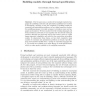Free Online Productivity Tools
i2Speak
i2Symbol
i2OCR
iTex2Img
iWeb2Print
iWeb2Shot
i2Type
iPdf2Split
iPdf2Merge
i2Bopomofo
i2Arabic
i2Style
i2Image
i2PDF
iLatex2Rtf
Sci2ools
103
click to vote
CPAIOR
2004
Springer
2004
Springer
Building Models through Formal Specification
Abstract. Over the past years, a number of increasingly expressive languages for modelling constraint and optimisation problems have evolved. In developing a strategy to ease the complexity of building models for constraint and optimisation problems, we have asked ourselves whether, for modelling purposes, it is really necessary to introduce more new languages and notations. We have analyzed several emerging languages and formal notations and found (to our surprise) that the already existing Z notation, although not previously used in this context, proves to a high degree expressive, adaptable, and useful for the construction of problem models. To substantiate these claims, we have both compiled a large number of constraint and optimisation problems as formal Z specifications and translated models from a variety of constraint languages into Z. The results are available as an online library of model specifications, which we make openly available to the modelling community. 1 Motivation ...
Related Content
| Added | 20 Aug 2010 |
| Updated | 20 Aug 2010 |
| Type | Conference |
| Year | 2004 |
| Where | CPAIOR |
| Authors | Gerrit Renker, Hatem Ahriz |
Comments (0)

